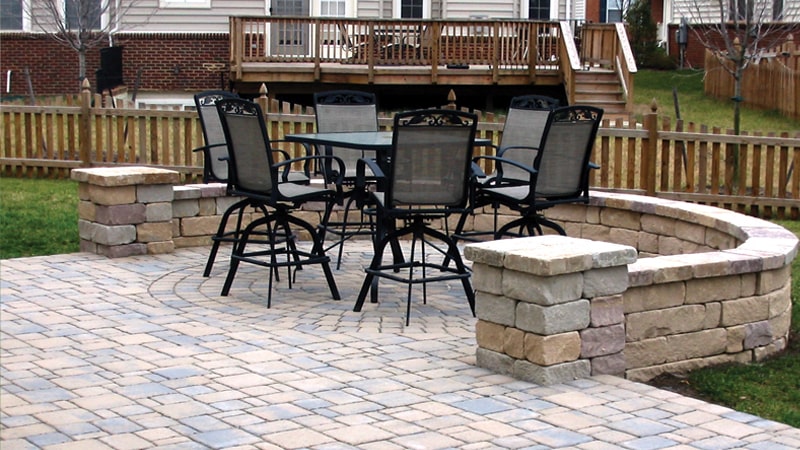Whether you’re installing fence materials yourself or hiring a fence contractor to do the work, it helps to know some basic fence terminology. Knowing what the different parts of a fence are called will make it easier to ask questions of your contractor or understand your fence installation instructions. Before considering a fence installation, you may wish to brush up on the following terms:
- Free Estimate
- Aluminized
- Barbed tape
- Barbed wire
- Bottom rail
- Brace band
- Cantilever slide gate
- Center stop
- Chain link
- Corner post
- Deer fence
- Diamond
- Diamond count
- Double swing gate
- Drop bar
- End post
- Fabric
- Fence line
- Fence tie
- Frame hinge
- Framework
- Galvanized
- Galvanized after weaving (GAW)
- Galvanized before weaving (GBW)
- Gate
- Gate frame
- Gate latch
- Gate opening
- Gate post
- Gauge
- Height
- High-tensile wire
- Hog ring
- Intermediate rail
- Knotted
- Knuckle
- Lattice fencing:
- Line post
- Line post cap
- Line rail clamp
- Loop cap
- Mesh
- Middle rail
- Offset hinge
- Ornamental fencing
- Panel clamp
- Perimeter fence
- Picket
- Pool code fence
- Post cap
- Post hinge
- Post & rail
- Post & wire
- Privacy fence
- PVC
- Rail
- Rail end
- Rail end band
- Rail spacing
- Raking
- Section
- Selvage
- Semi-private
- Sight board
- Single swing gate:
- Sleeve, top rail
- Split Rail
- Stair stepping
- Stretching
- Swage
- Tension band
- Tension bar
- Tension wire
- Terminal post
- Tie
- Top rail
- Truss rod
- Turnbuckle
- Vinyl fence
- Wire fencing
- Wood fencing
- Woven wire
- Wrought iron
Aluminized
In chain link fence, describes fabric woven from steel wire that is coated with aluminum before weaving. Could also apply in decorative fence or railing system.
Barbed tape
Strip of metal, machined to produce clusters of sharp points.
Barbed wire
Wire constructed with sharp edges or points arranged at intervals. Most often used in agricultural fencing, where it is suitable for cattle but not horses or fleeced animals.
Bottom rail
Horizontal member of the framework running continuously along the bottom edge of the fence.
Brace band
A strip of metal shaped to fit around a post and used with a carriage bolt and nut to attach the rail end to the post. Also used for attaching barbed wire, tension wire, and other items to a terminal post.
Cantilever slide gate
Any horizontal slide gate spanning an opening, lacking a top or bottom support within that opening. It is counter-balanced with additional framework (weight) to support the gate while it is closed.
Center stop
A device to receive and hold the drop bar on a double gate.
Chain link
A fence made from steel posts and chain link fabric, typically galvanized but can be vinyl covered. Fabric wires run vertically and are bent and hooked together in a zig-zag pattern creating a diamond shape. Very commonly used commercially and can be topped with barbed wire for security.
Corner post
A post at the corner where two lines of fencing meet, usually at a 90-degree angle.
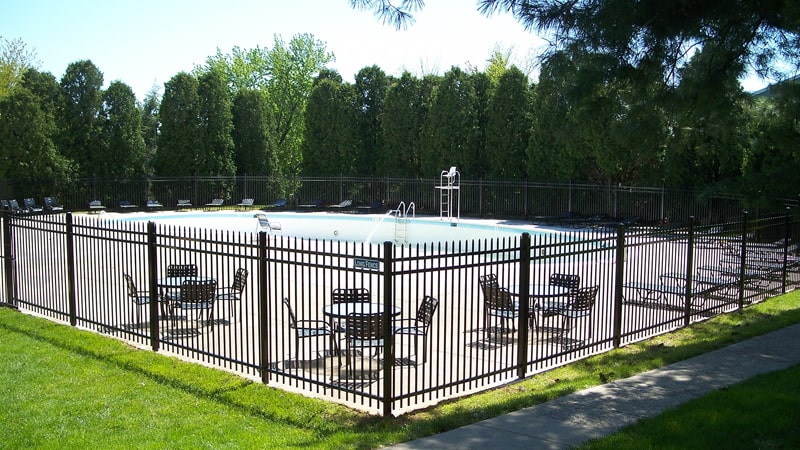
Deer fence
A fence 7½ to 8 feet high designed to prevent the passage of deer.
Diamond
The mesh opening formed by the woven wires in chain link fence fabric.
Diamond count
The number of diamond openings from one edge of the fabric to the other. The count of a given fabric shall begin at the first completed diamond at one edge and continue to the unfinished half or full opening at the other edge.
Double swing gate
A hinged gate with two leaves, most often used to gate driveways or other areas that demand a wide gate.
Drop bar
Component of a double gate latch assembly. (Sometimes called drop rod)
End post
A post that marks the end of a fence line, with holes on only one side for attaching rails. End posts are typically used as gate posts or terminal posts, such as where the fence abuts a house.
Fabric
Fencing material made from wire helically wound and interwoven in such a manner as to provide a continuous mesh without knots or ties except in the form of knuckling or of twisting the ends of wires to form the selvage of the fabric.
Fence line
The actual position of the fence.
Fence tie
Ties that are used in chain link fencing to attach the fence to the line posts.
Frame hinge
A fitting that attaches to the gate frame and functions with the post hinge to enable the gate to swing.
Framework
The basic structure supporting the installed fabric and gates, namely the posts, top rails, braces and bottom rail (when specified).
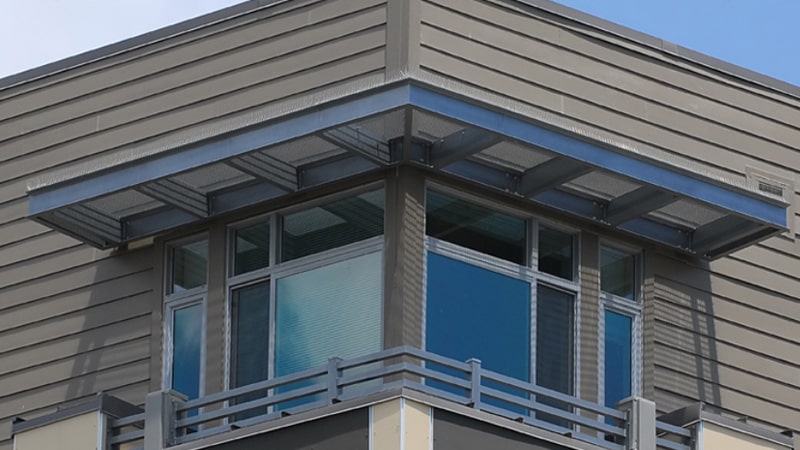
Galvanized
A protective zinc coating applied to steel or iron to prevent rusting. Can refer to steel fasteners, such as nails or screws, or steel fabric.
Galvanized after weaving (GAW)
In chain link fabric, describes steel fabric that is zinc coated after weaving.
Galvanized before weaving (GBW)
In chain link fabric, describes steel fabric that is zinc coated before weaving. This process provides a smoother fabric with a more uniform zinc coating, enhancing the rust protection.
Gate
Structure that allows access through the fence.
Gate frame
The structural members of the gate.
Gate latch
A fitting to hold the gate in place when closed.
Gate opening
The clear distance between the gate posts.
Gate post
The post to which a gate is attached by hinges and latches. It may also be used as a terminal post.
Gauge
Diameter of the coated wire used to make the fabric. The finer the wire, the higher the gauge. Also the thickness of the tubing or pipe used in the framework.
Height
In chain link fence, the distance before stretching from the top edge of knuckle or twist to the bottom edge of the knuckle or twist of the fabric.
High-tensile wire
Wire fencing made of strong wires that run horizontally through insulators, attached to fence posts.
Hog ring
A pre-formed open wire clip designed to close up into a ring to secure chain link fabric to horizontal tension wire.
Intermediate rail
Horizontal member of the framework running continuously at any point between the top and bottom of the fence (sometimes called middle rail).
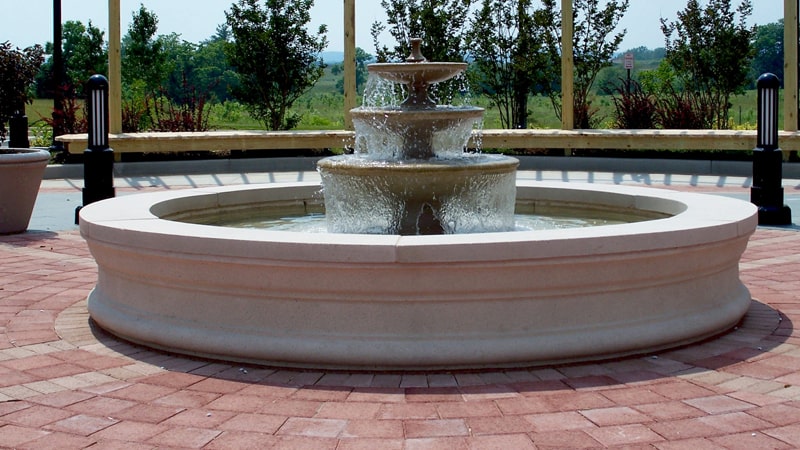
Knotted
Mesh that is produced by knotting together steel wires that have been arranged vertically and horizontally.
Knuckle
The selvage obtained by interlocking adjacent pairs of wire ends and bending the wire back into a loop.
Lattice fencing:
Wood fencing, usually cedar, constructed of prefabricated lattice panels.
Line post
A post located between terminal or end posts to provide support for the fence.
Line post cap
A cap or top with a loop used to position the top rail or tension wire on top of the line posts. (Also called loop cap)
Line rail clamp
A two-piece clamp with carriage bolts and nuts designed for 180 degree horizontal rail connections to a line post.
Loop cap
In chain link fencing, a cap for a line post that has a loop through which to pass the top rail or tension wire.
Mesh
Fencing which results from the connection of vertical and horizontal wires. Depending on the connection method and diameter of the wires used, the tighter the mesh weave, the more resistant. In chain link fabric, the clear distance between parallel wires forming the diamond.
Middle rail
Same as intermediate rail.
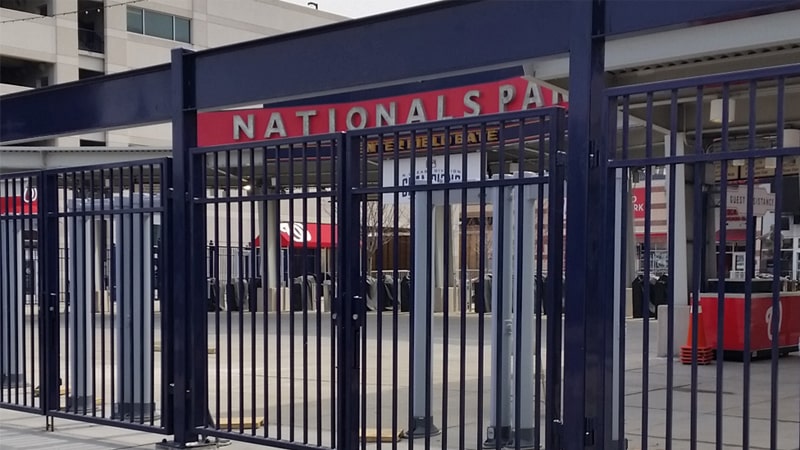
Offset hinge
A swing gate hinge that permits the gate to swing 180 degrees from the closed to the open position.
Ornamental fencing
Any fence that is made of, or imitates, a cast iron fence. Provides for traditional fencing needs with added aesthetic appeal.
Panel clamp
A two-piece clamp with carriage bolt and nut designed to secure prefabricated panels together.
Perimeter fence
Fence line around the outer boundary of a piece of property.
Picket
A vertical fence board or element that attaches to the rails. Pickets can be made from any material but are most commonly used in wood, aluminum, iron and vinyl fences, and are usually evenly spaced.
Pool code fence
Any fence that meets the local municipal requirements regarding pool fencing; i.e. height, space between pickets, anti-climb, direction of gates and height of the gate latch.
Post cap
A fitting that covers the top of a fence post, usually to exclude water from entering the post, but also used as a decorative element in vinyl and cedar.
Post hinge
A fitting that attaches to the gate post, and functions with the frame hinge receptor, permitting the gate to swing.
Post & rail
Any fence made from horizontal rails fastened to vertical posts
Post & wire
A lower cost alternative to post & rail; when used for horses it should include a sight board.
Privacy fence
A fence with close fitting vertical pickets that block views into a yard or area.
PVC
Poly-vinyl chloride coating on fence materials.
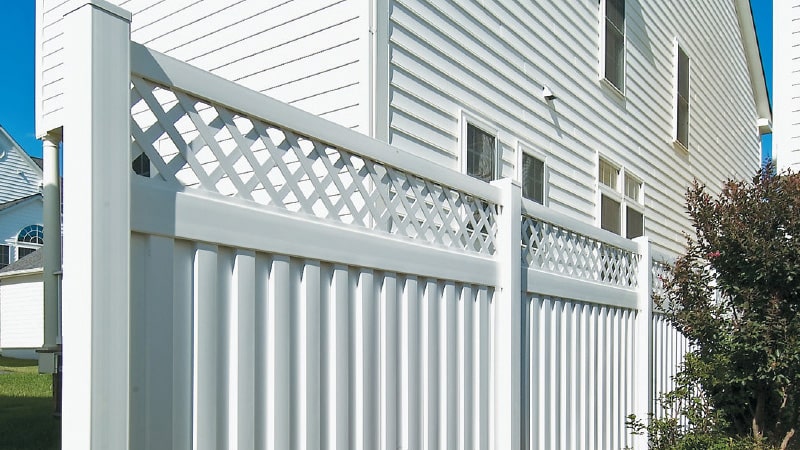
Rail
A horizontal support element to which fence boards or pickets are attached. The distance between rails is known as rail spacing.
Rail end
A cup-shaped fitting used with a brace band to connect the top rail or brace to a post.
Rail end band
Same as brace band.
Rail spacing
The distance between the rails on a fence. In general, the more rails there are, the closer the spacing.
Raking
The installation of fence sections that allow the fence to follow the grade.
Section
The run of fence between two posts.
Selvage
The edge finish on woven chain link fabric joining pairs of pickets. The selvage may be knuckled or twisted (barbed). Standard selvage is K&K when the fabric is under 72″, and K&B when the fabric is 72″ high or above.
Semi-private
Fence that provides a balance of privacy and airflow. Slight spacing between the pickets allows light and air to enter, while still offering just the right amount of privacy.
Sight board
A top board running between the posts on a fence constructed of posts and wire. A horse’s nearsightedness in combination with their size, startle reflex and tendency to run makes it imperative to install a ‘sight board’ so they don’t run into or through the wire fence.
Single swing gate:
Any hinged gate that is built with only one leaf.
Sleeve, top rail
A fitting used to join two pieces of top rail together end to end, when a swaged top rail is not used.
Split Rail
A post and rail fence made from rough hewn wood, usually consisting of two or three horizontal rails that fit into notched posts.
Stair stepping
A method for installing fence on a steep grade, with uniform sections installed at different heights to create a stair-step appearance.
Stretching
The process of putting tension at the end of the fabric to make it hang uniformly and taught along the line of fence between terminal posts.
Swage
The formed end of a piece of top rail so that it will fit into and join another piece of top rail.
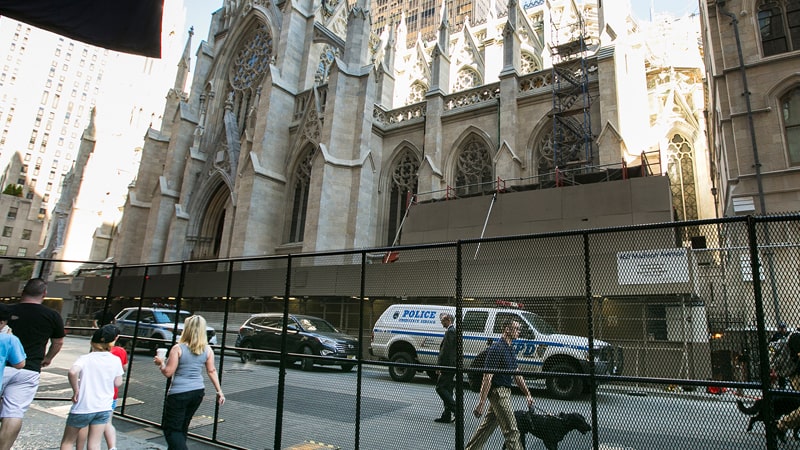
Tension band
– In chain link fence, an offset strip of metal shaped to fit around the terminal post and used with a carriage bolt and nut to attach the tension bar to the post.
Tension bar
The bar used with tension bands or other post connectors to secure the fabric to a terminal post. The bar is slid down into the very last fabric lace where it is closest to the terminal post.
Tension wire
A wire, with or without a pattern on it. Typically used along the top of a chain link fence in place of a top rail or along the bottom of a chain link fence for additional security. (Sometimes called coil spring wire, or coil wire)
Terminal post
The load-bearing post for a line of fencing. The terminal post can be a corner, end or gate post.
Tie
Wire, clip, or band used to attach the fabric to the top rail and line posts.
Top rail
Horizontal member of the framework running from terminal post to terminal post on top of the line posts.
Truss rod
A tension rod, used for bracing in gates and at terminal posts. May be threaded at one or both ends or contain a turnbuckle for adjusting tension.
Turnbuckle
A tightening device used with an adjusting nut and a truss rod.
Vinyl fence
A prefabricated fence made of PVC plastic. Vinyl fencing can imitate a variety of fence designs, including post & rail, picket, lattice, and privacy. It tends to be easy to clean, resists weathering and has low maintenance requirements.
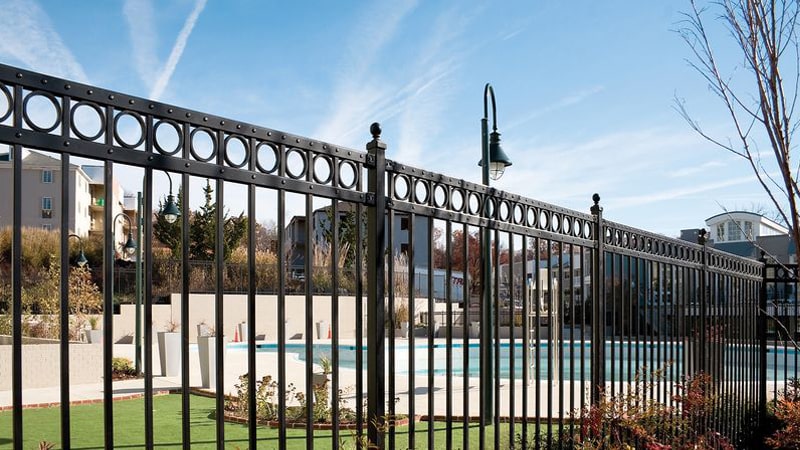
Wire fencing
Fencing constructed of lines of wire pulled tight between fence posts. Most often used for agricultural fencing needs.
Wood fencing
Any fence made from wood materials. Requires a higher level of maintenance than other fencing, in the form of painting or staining, to combat weathering.
Woven wire
Fencing made of smooth horizontal wire held together by vertical wires or “stays”. The horizontal spacing is closer toward the bottom and wider at the top. It is held in place with wood posts or metal T-posts. Suitable for horses and ideal for goats, sheep, pigs and poultry because these animals can squeeze through larger-spaced wire and dig under or climb over other fences.
Wrought iron
Fencing made of hardened, welded steel. More expensive than other fencing, but wrought iron fence is incredibly strong, long lasting and comes with the added options of ornamental design.
